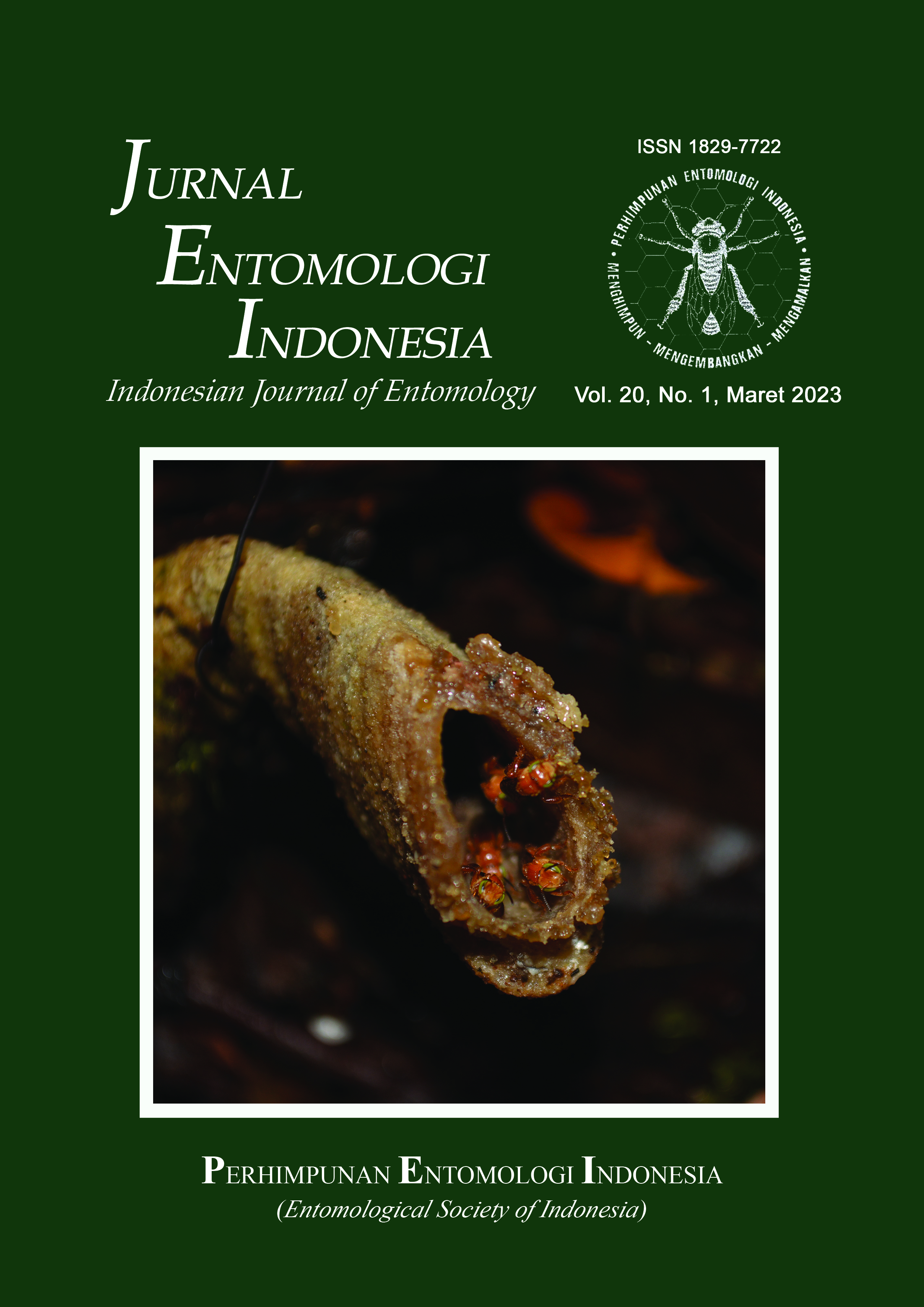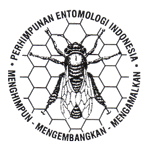Keragaman genetik cendawan entomopatogen Metarhizium anisopliae (Metsch.) berasal dari tanah pertanaman kelapa sawit berdasarkan penanda RAPD
Genetic diversity of the entomopathogenic Metarhizium anisopliae (Metsch.) from oil palm planting soil based on RAPD markers
DOI:
https://doi.org/10.5994/jei.20.1.22Keywords:
entomopathogenic fungi, genetic diversity, ITS sequencing, RAPDAbstract
Metarizhium anisopliae (Metsch.) is an entomopathogenic fungus that attacks Oryctes rhinoceros (Linnaeus). This fungus is one of the potential bioagents that is environmentally friendly. The purpose of this study was to isolate the fungus M. anisopliae from various oil palm plantation soil samples and to see its genetic diversity based on RAPD markers. The method used in this research is the morphological and the molecular identification of M. anisopliae (ITS), and genetic diversity testing using RAPD markers. Fifteen isolates of M. anisopliae isolated from 15 oil palm plantation sites in North Sumatra were examined for their molecular diversity. On the basis of morphological characteristics, all isolates were identified as M. anisopliae. The result of sequencing with the ITS primer showed that all isolates of M. anisopliae isolated from soil had a 85–99% homology of with M. anisopliae and M. brunneum reference strains from gen bank database National Center Biotechnology Information (NCBI). Eight RAPD primers generated 39 scorable bands which 38 (98,44%) of them were polymorphic. Clustering analysis was performed based on RAPD profiles using Neighbour-Joining Tree method that formed 3 groups.
Downloads
References
Bai NS, Sasidharan TO, Remadevi OK, Dharmarajan P, Pandian SK, Balaji K. 2015. Morphology and RAPD analysis of certain potentially ento-mopathogenic isolates of Metarhizium anisopliae Metsch. (Deuteromycotina: Hypocreales). Journal of Microbiology and Biotechnology Research 5:34–40.
BPS Sumut. 2016. Propinsi Sumatera Utara Dalam Angka. Tersedia pada: https://sumut.bps.go.id/ [diakses 20 Oktober 2021].
Bridge PD, Williams MAJ, Prior C, RR. Paterson M. 1993. Morphological, biochemical and mole-cular characteristics of Metarhizium anisopliae and M. flavoviride. Journal of General Microbiology 139:1163–1169. DOI: https://doi.org/10.1099/00221287-139-6-1163.
Dong T, Zhang B, Jiang Y, Hu Q. 2016. Isolation and classification of fungal whitefly entomo-pathogens from soils of Qinghai-Tibet Plateau and Gansu Corridor in China. PLOS ONE 11: e0156087. DOI: https://doi.org/10.1371/journal.pone.0156087.
Driver F, Milner RJ, Trueman JWH. 2000. A taxonomic revision of Metarhizium based on a phylogenetic analysis of rDNA sequence data. Mycological Research 104:134–150. DOI: https://doi.org/10.1017/S0953756299001756.
Fernandes EKK, Keyser CA, Pong JP, Rangel DEN. 2009. Characterization of Metarhizium species and varieties based on molecular analysis, heat tolerance and cold activity. Journal of Applied Microbiology 108:115–128. DOI: https://doi.org/10.1111/j.1365-2672.2009.04422.x.
Freed S, Feng-Liang J, Shun-Xiang R. 2014. Intraspecific variability among the isolates of Metarhizium anisopliae var. anisopliae by RAPD markers. International Journal of Agriculture and Biology 16:899‒904.
Freed S, Jin F-L, Ren S-X. 2011. Determination of genetic variability among the isolates of Metarhizium anisopliae var. anisopliae from different geographical origins. World Journal of Microbiology and Biotechnology 27:359–370. DOI: https://doi.org/10.1007/s11274-010-0466-8.
Ghayedi S, Abdollahi M. 2013. Biocontrol potential of Metarhizium anisopliae (Hypocreales: Clavicipitaceae), isolated from suppressive soils of the Boyer-Ahmad region, Iran, against J2S of Heterodera avenae. Plant Protection Reserach 53:165–171. DOI: https://doi.org/10.2478/jppr-2013-0025.
Glare TR, Milner RJ, Beaton CD. 1996. Variation in Metarhizium, a genus of fungal pathogens attacking Orthoptera: Is phialide morphology a useful taxonomic criterion? Journal of Orthoptera Research 5:19–27 DOI: https://doi.org/10.2307/3503572.
Inglis GD, Duke GM, Goettel MS, Kabaluk JT. 2008. Genetic diversity of Metarhizium anisopliae var. anisopliae in southwestern British Columbia. Journal of Invertebrate Pathology 98:101–113. DOI: https://doi.org/10.1016/j.jip.2007.12.001.
Kepler RM, Rehner SA. 2013. Genome‐assisted development of nuclear intergenic sequence markers for entomopathogenic fungi of the Metarhizium anisopliae species complex. Molecular Ecology Resources 13:210–217. DOI: https://doi.org/10.1111/1755-0998.12058.
Keyser CA, De Fine Licht HH, Steinwender BM, Meyling NV. 2015. Diversity within the entomopathogenic fungal species Metarhizium flavoviride associated with agricultural crops in Denmark. BMC Microbiology 15:249. DOI: https://doi.org/10.1186/s12866-015-0589-z.
Korosi G, Wilson B, Powell K, Ash G, Reineke A, Savocchia S. 2019. Occurrence and diversity of entomopathogenic fungi (Beauveria spp. and Metarhizium spp.) in Australian vineyard soils. Journal of Invertebrate Pathology 164:69–77 DOI: https://doi.org/10.1016/j.jip.2019.05.002.
Kumar N, Thakur SK. 2014. Randomly amplified polymorphic DNA: A brief review. American Journal Animal and Veterinary Science 9:6–13. DOI: https://doi.org/10.3844/ajavsp.2014.6.13.
Meyling VN and Elibenberg J. 2007. Ecology of the entomopathogenic fungi Beauveria bassiana and Metarhizium anisopliae in temperate agroecosystemens: Potential for conservation biological control. Biological Control 43:145–155. DOI: https://doi.org/10.1016/j.biocontrol.2007.07.007.
Milner RJ, Lim RP, Hunter DM. 2002. Risks to the aquatic ecosystem from the application of Metarhizium anisopliae for locust control in Australia. Pest Management Sceince 58:718–723. DOI: https://doi.org/10.1002/ps.517.
Navarro-Barranco H, Brunner-Mendoza C, Reyes-Montes M del R, Duarte-Escalante E, Toriello C. 2019. Phenotypic and molecular analysis of Mexican Metarhizium anisopliae strains. Revista Mexicana de Biodiversidad 90:e902643. DOI: https://doi.org/10.22201/ib.20078706e.2019.90.2643.
Nishi O, Iiyama K, Yasunaga-Aoki C, Shimizu S. 2017. Species associations and distributions of soil entomopathogenic fungi Metarhizium spp. in Japan. Mycology 8:308–317. DOI: https://doi.org/10.1080/21501203.2017.1386244.
Pereira de Lyra M do CC, Bastos da Silva MLR, Bezerra Cavalcanti VAL, Santo Mergulhão ACE. 2012. Characterization of Metarhizium anisopliae using amplifed ribossomal DNA restriction analysis (ARDRA) and internal transcribed spacer (ITS) sequence analysis. African Journal of Biotechnology 11:16635–16639. DOI: https://doi.org/10.5897/AJB12.906.
Pong K, Mslim R, Azmi W, Kamarudin N, Ali DSR. 2017. Genetic variation of entomopathogenic fungi, Metarhizium anisopliae and Isaria amoenerosea and their pathogenicity against subterranean termite, Coptotermes curvignathus. Journal of Oil Palm Research 29:35–46. DOI: https://doi.org/10.21894/jopr.2017.2901.04.
Promega. 2019. Wizard Genomic DNA Purification Kit Technical Manual. Tersedia pada: https://worldwide.promega.com/products/nucleic-acid-extraction/genomic-dna/wizard-genomic-dna-purification-kit/?catNum=A1120. [diakses 20 Oktober 2021].
Ranga V, Saini GK. 2011. Biochemical and molecular characterization of wild-type and fused protoplasts of Beauveria bassiana and Metarhizium anisopliae. Folia Microbiologica 56:289–295. DOI: https://doi.org/10.1007/s12223-011-0055-8.
Rachappa V, Lingappa S, Patil RK. 2009. Growth characteristics and bio-efficacy of different isolates of Metarhizium anisopliae (Metschnikoff) Sorokin against certain key insect pests. Journal of Biology Control 23:271–276. DOI: https://doi.org/10.18311/jbc/2009/3675.
Sapna Bai N, Sasidharan TO, Remadevi OK, Dharmarajan P. 2015. Morphology and RAPD analysis ofcertain potentially entomopathogenic isolates of Metarhizium anisopliae Metsch. (Deuteromycotina: Hypocreales). Journal of Microbiology and Biotechnology Research 5:34–40. DOI: https://doi.org/10.31357/jtfe.v5i1.2497.
Schneider S, Rehner SA, Widmer F, Enkerli J. 2011. A PCR-based tool for cultivation-independent detection and quantification of Metarhizium clade 1. Journal of Invertebrate Pathology 108:106–114. DOI: https://doi.org/10.1016/j.jip.2011.07.005.
Serna-Domínguez MG, Andrade-Michel GY, Rosas-Valdez R, Castro-Félix P, Arredondo-Bernal HC, Gallou A. 2019. Genetic diversity of the Metarhizium anisopliae complex in Colima, Mexico, using microsatellites. Fungal Biology 123:855–863. DOI: https://doi.org/10.1016/j.funbio.2019.09.005.
Sevim A, Demir I, Höfte M, Humber R, Demirbag Z. 2010. Isolation and characterization of entomopathogenic fungi from hazelnut-growing region of Turkey. BioControl 55:279–297. DOI: https://doi.org/10.1007/s10526-009-9235-8.
Sevim A, Höfte M, Demirbağ Z. 2012. Genetic variability of Beauveria bassiana and Metarhizium anisopliae var. anisopliae isolates obtained from the Eastern Black Sea Region of Turkey. Turkish Journal of Biology 3:255–265. DOI: https://doi.org/10.3906/biy-1009-118.
St Leger RJ, Wang JB. 2020. Metarhizium: Jack of all trades, master of many. Open Biology 10:200307. DOI: https://doi.org/10.1098/rsob.200307.
Strom NB, Bushley KE. 2016. Two genomes are better than one: History, genetics, and biotechnological applications of fungal heterokaryons. Fungal Biology and Biotechnology 3:1-14. DOI: https://doi.org/10.1186/s40694-016-0022-x.
Stone LBL, Bidochka MJ. 2020. The multifunctional lifestyles of Metarhizium: Evolution and appli-cations. Applied Microbiology and Biotechnology 104:9935–9945. DOI: https://doi.org/10.1007/s00253-020-10968-3.
Susanto A, Prasetyo AE, Sudharto S, Priwiratama H, Roziansha TAP. 2012. Pengendalian Terpadu Oryctes rhinoceros di Perkebunan Kelapa Sawit. Medan: CV. Mitra Karya.
Tangthirasunun N, Poeaim S, Soytong K, Sommartya P, Popoonsak S. 2010. Variation in morphology and ribosomal DNA among isolates of Metarhizium anisopliae from Thailand. Journal of Agiculture Technology 6:317–329.
Tiago PV, Carneiro-Leão MP, Lima MLA, Oliveira NT, Luna-Alves Lima EA. 2011. Polymorphism in Metarhizium anisopliae var. anisopliae (Hypocreales: Clavicipitaceae) based on internal transcribed spacer-RFLP, ISSR and intron markers. Genetics and Molecular Research 10:1565–1575. DOI: https://doi.org/10.4238/vol10-3gmr1069.
Trizelia. 2005. Cendawan entomopatogen Beauveria bassiana (Bals.) Vuill. (Deuteromycotina: Hyphomycetes): Keanekaragaman genetik, karakterisasi fisiologi dan virulensinya terhadap Crocidolomia pavonana (F.) (Lepidoptera: Pyralidae). Disertasi. Bogor: Institut Pertanian Bogor.
Trizelia T, Santoso T, Sosromarsono S, Rauf A, Sudirman LI. 2013. Keragaman genetik berbagai isolat Beauveria bassiana (Bals.) Vuill. (Deuteromycotina: Hyphomycetes) dan virulensinya terhadap Crocidolomia pavonana. Jurnal Natur Indonesia 14:176–183. DOI: https://doi.org/10.31258/jnat.14.3.176-183.
Velásquez VB, Cárcamo MP, Meriño CR, Iglesias AF, Durán JF. 2007. Intraspecific differentiation of Chilean isolates of the entomopathogenic fungi Metarhizium anisopliae var. anisopliae as revealed by RAPD, SSR and ITS markers. Genetics and Molecular Biology 30:89–99. DOI: https://doi.org/10.1590/S1415-47572007000100017.
Yokoyama E, Yamagishi K, Hara A. 2002. Group-I intron containing a putative homing endonuclease gene in the small subunit ribosomal DNA of Beauveria bassiana IFO 31676. Molecular Biology and Evolution 19:2022–2025. DOI: https://doi.org/10.1093/oxfordjournals.molbev.a004025.
Zimmerman G. 1993. The entomopathogenic fungus Metarhizium anisopliae and its potential as a biocontrol agent. Pest Management Science 37:375–379. DOI: https://doi.org/10.1002/ps.2780370410.
Downloads
Published
How to Cite
Issue
Section
License
Copyright (c) 2023 Desianty Dona Normalisa Sirait, Maryani Cyccu Tobing, Irda Safni

This work is licensed under a Creative Commons Attribution 4.0 International License.
Authors who publish with this journal agree to the following terms:
- Authors retain copyright and grant the journal right of first publication with the work simultaneously licensed under a Creative Commons Attribution 4.0 International License that allows others to share the work with an acknowledgement of the work's authorship and initial publication in this journal.
- Authors are able to enter into separate, additional contractual arrangements for the non-exclusive distribution of the journal's published version of the work (e.g., post it to an institutional repository or publish it in a book), with an acknowledgement of its initial publication in this journal.
- Authors are permitted and encouraged to post their work online (e.g., in institutional repositories or on their website) prior to and during the submission process, as it can lead to productive exchanges, as well as earlier and greater citation of published work (See The Effect of Open Access).








